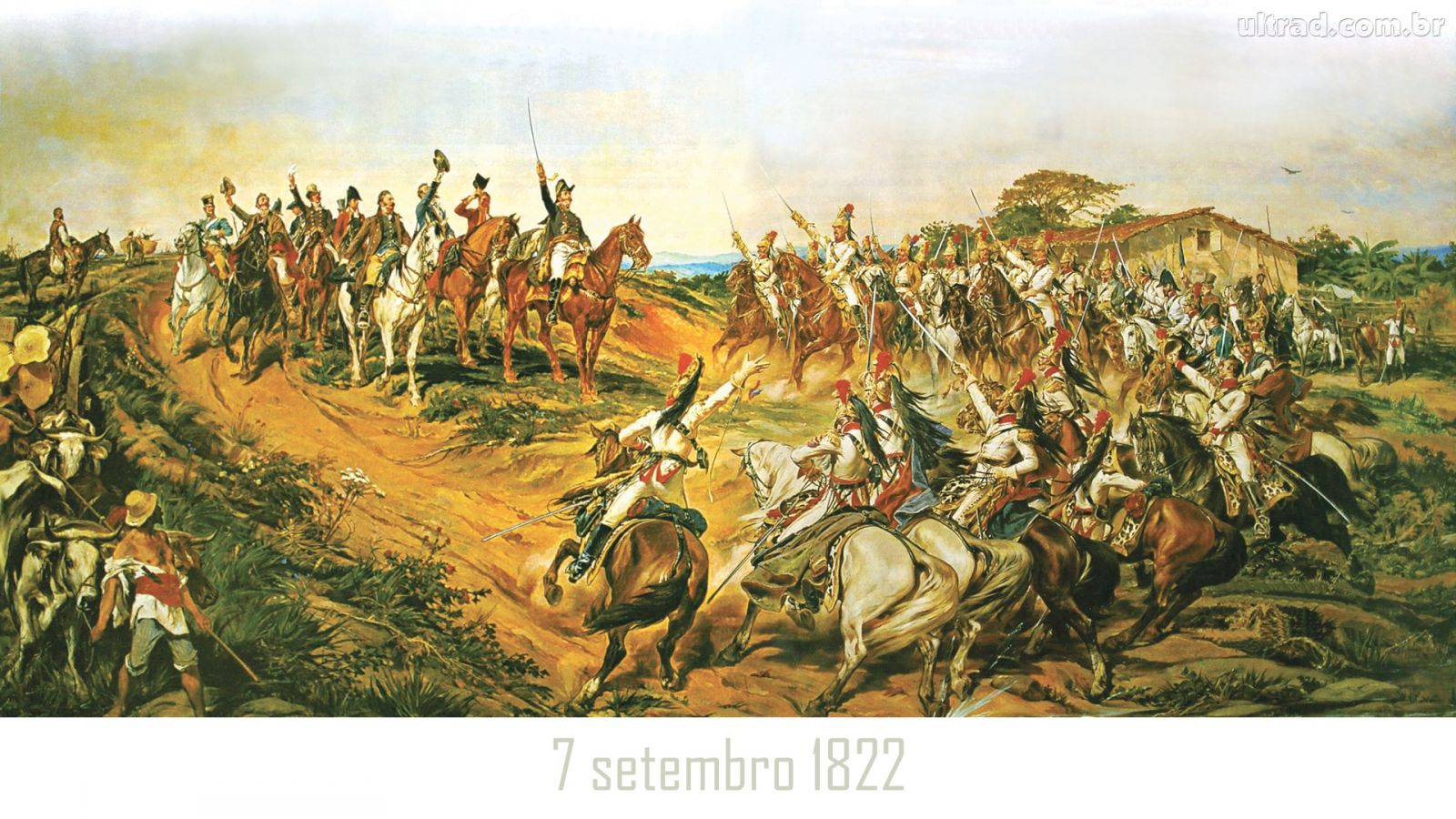Este post também está disponível em:
Português
English
Independence of Brazil – Breaking of colonial ties in Brazil
1. Introduction
As you may have realised, we have presented a reading of different factors related to the emancipation of Portuguese America.
The growth and diversification of society, the installation of the Portuguese Court in Brazil and the protest movements thus constitute a set of events that help us to better understand Brazil’s political and economic majority.
However, in this topic we will look at some significant episodes from the last years of the colonial period, in order to complement our lessons on the process of struggle against Portugal’s domination of Brazil.
We can start by saying that the “Grito do Ipiranga” represents a symbolic and political gesture by the then Prince Regent Dom Pedro, who officially instituted Brazil’s independence.
This event, which served to formalise emancipation, was also a way for the Brazilian aristocracy to remain in power.
The act of proclaiming Brazil’s independence came about as an agreement between the national elite and the monarch.
Even the date of Brazil’s independence can vary.
Although Dom Pedro announced independence on 7 September 1822, the Bahians had 2 July 1823 as the date of Brazil’s liberation, when the Portuguese troops, led by Madeira de Melo, were defeated by Brazilian forces financed by the plantation owners and commanded by Lord Cochrane.
Portugal, for its part, only formally recognised Brazil’s independence in August 1825, when the Brazilian government compensated the former metropolis.
At that time, Portugal was paid £2 million.
This was then the first episode of a new dependency: Brazil’s foreign debt.
But that’s another story. Let’s go back to 1817, when the northeastern population fought for the liberation of Brazil, which will be discussed in the next section.
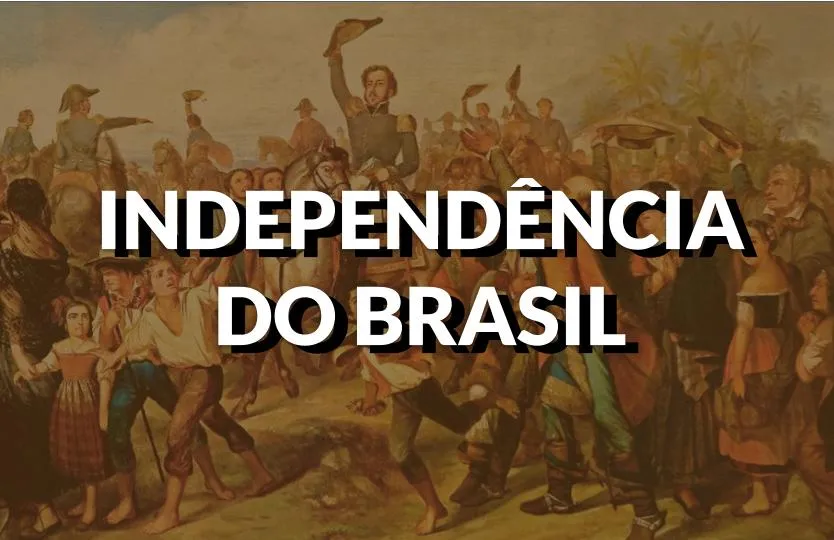
2. The Revolution in the Northeast
As you already know, the 18th century saw economic growth in the southeast.
Mining transformed the captaincies of Minas and Rio de Janeiro. On the other hand, the former sugar cane producing region went through a serious financial crisis.
In fact, there was economic inequality between these two regions: the southeast and the northeast.
In addition to the situation of regional inequality in the producing economy, the population at that time had to pay heavy taxes: to support the high expenses of the Court (which was not satisfied with the substantial donations from the Luso-Brazilian elite), and to finance the military campaigns of the Portuguese Empire.
Jurandir Malerba (2000, p. 242) shows us a specific case of Court spending, but one that had important consequences for Rio’s economy.
As a result of the famine and inflation in food prices, the population of Rio de Janeiro found itself in the midst of the biggest supply crisis in living memory and angrily asked the king to take swift action.
The Marquis of Valada then produced an extensive report explaining to His Majesty the reasons for the inflation, which was particularly serious with regard to poultry for court consumption, which the Portuguese court could no longer supply.
The lack of poultry on the market was just one of the consequences of the high consumption of the entourage of nobles and the royal family in Brazil.
However, this case serves as an illustrative example of the situation in which the population lived, which had to pay high taxes, not only to pay for the daily expenses of the Court, but also for the infrastructure works of the new Kingdom.
On the other hand, in the north-east, some specific factors – such as the costs of financing the war – had a decisive influence on the uprising of 1817.
The taxes created in 1812, the contributions – including personnel – to the troops in the Guyana campaign (invaded at the end of 1808 as a reprisal for Portugal’s occupation and to guarantee the borders established by the first Treaty of Utrecht) and the worsening social situation, with the drought of 1816, favoured the spread of liberalism.
We introduced liberal ideas in the previous chapters, when we referred to the movements challenging the absolutist regime and mercantilist politics.
The “anti-Lusitanian” movement that took place in Pernambuco also had the support of the Freemasons.
Among the Masonic lodges in Pernambuco was the Areópago de Itambé (see about this Masonic lodge in “Conspiracy of the Suassunas“.
The fact that some have only one property: their labour power, while others own the means of production, is not denied, only omitted in the liberal ideology.
In this sense, all men are equal, a fact enshrined in the fundamental principle of the bourgeois constitution: all are equal before the law, the concrete basis of formal equality between the members of a society.
In an extension of this, a second idea proposes the common good (the Commonwealth), according to which social organisation based on property and freedom serves the good of all.
A corollary of this proposition is that if there is no antagonism between social classes, action can be guided simply by reason – hence rationalism.
This is the core of the ideological proposition, which aims for the consensual domination of the workers, through the operation of identifying the interests of the ruling class (the maintenance of the current social order) with the interests of society as a whole – the nation.
In this sense, the factors that triggered the revolution of 1817 had already been forming since the conspiracy of 1801 (that of the Suassunas).
But it was triggered by the events of that moment. Specifically, the economic crisis and social discontent.
The combination of two economic factors was decisive in mobilising the rural aristocracy: the fall in the price of sugar and cotton on the international market and the rise in the price of slaves.
Meanwhile, the revolution in Pernambuco, which broke out in March 1817, united different social strata (military, landowners, judges, artisans, merchants and priests) who were unhappy with the privileges granted to the Portuguese.
The Brazilian military, in particular, were dissatisfied because the best command posts were reserved for the Portuguese.
Thus, anti-Portuguese sentiment spread from Recife to other cities: Alagoas, Paraíba and Rio Grande do Norte.
Boris Fausto (2007, p. 129) narrates the outcome of the revolution as follows:
Emissaries were sent to the other captaincies in search of support and to the United States, England and Argentina, also in search of support and recognition.
The revolt advanced through the hinterland, but the Portuguese forces attacked soon afterwards, blockading Recife and landing in Alagoas.
The fighting took place in the interior, revealing the unpreparedness and disagreements between the revolutionaries.
In the end, Portuguese troops occupied Recife in May 1817.
This was followed by the arrests and executions of the rebellion’s leaders. The movement lasted more than two months and left a deep mark on the northeast.
3. The Liberal Revolution of Porto
The Liberal Revolution of Porto was an event that took place in Portugal in 1820.

A Revolução Liberal do Porto
But despite the immense distance between the Iberian Peninsula and the New Continent, the repercussions of that movement were definitive for Brazil’s final act of independence.
And, once again, liberal ideas served as the backdrop to this revolution.
In fact, the Portuguese discontent began with the arrival of the Court in Brazil.
The absence of the king and the monarchy’s administrative apparatus created a state of political uncertainty in Portugal.
In turn, the void left by King João was filled by a “regency council” led by the English Marshal Willian Carr Beresford (he led the expulsion of the French from Portugal).
The English marshal, by preventing Lusitanian soldiers from assuming high military posts, generated a great deal of dissatisfaction within the army.
The commercial privileges granted to England, with the opening of Brazilian ports, was another reason for discontent among the Portuguese.
The revolters had the following objectives: to limit English influence over the nation, and to resume the colonialist relationship with Brazil, reinstating the Colonial Pact.
However, times were different and it would have been difficult for the Brazilian elite to accept such an agreement, don’t you think?
Remember the significant changes that have taken place in Brazil since the arrival of the royal family.
Would you agree that in 1820 Brazil was less of a colony and more of an empire?
Colonial Pact – a system that lasted in Brazil until 1808, it determined the political and economic relations between the colony and the metropolis.
- The colony could only trade with the metropolis.
- The colony had to supply goods at a price set by the metropolis.
- The colony had to produce what the metropolis produced.
- The colony had to consume the manufactured goods produced in the metropolis.
In addition to the aforementioned demands of the Portuguese revolutionaries, the immediate return of the Court to Portugal was demanded.
They wanted to re-establish the monarchy, but under the condition that the king be subject to a constitutional charter.
The revolutionaries formed the “Provisional Junta of the Supreme Government of the Kingdom”, a heterogeneous group of representatives from the clergy, the nobility and the army.
In Brazil, meanwhile, disputes began between two groups: those in favour of the return of Dom João VI, the “Portuguese faction”, which was “made up of high-ranking military officers, bureaucrats and merchants interested in subordinating Brazil to the Metropolis, if possible according to the standards of the colonial system”.
The other group, which came to be called the “Brazilian party”, was made up of large landowners from the captaincies close to the capital, bureaucrats and members of the judiciary born in Brazil.
Added to these were the Portuguese whose interests had become linked to those of the colony: merchants adjusted to the new circumstances of free trade and investors in land and urban property, often linked by marriage to the people of the colony.
The interests of the Portuguese elite in relation to Brazil became clear in the episode of the Porto Revolution. Opposing groups formed there, either in favour or against the king’s departure.
The tense relationship between this elite and those who remained in Portugal culminated in 1820. That year saw the start of the Porto Revolution.
It was a liberal movement, aimed at convening a constituent assembly, but which demanded the king’s immediate return to the metropolis.
Even after the Industrial and French revolutions, the monarch remained a symbolic and real reference point for power, both in Portugal and Brazil.
On the other hand, the bourgeois class in both countries (merchants, bankers, liberal professionals, etc.) organised to approve a constitution (a document that would regulate the kingdom’s government policy in the form of laws).
Therefore, while certain practices continued as before – such as worshipping the king – others changed as a result of the bourgeoisie seeking legitimate ways to exercise power within the monarchical regime.
The “Portuguese faction” won out. The king returned to Portugal in April 1821, after thirteen years in Brazil.
His return was accompanied by around 4,000 people.
His son Pedro (de Alcântara Francisco António João Carlos Xavier de Paula Miguel Rafael Joaquim José Gonzaga Pascoal Cipriano Seraim de Bragança e Bourbon), the future Dom Pedro I, stayed in Brazil.
During 1821, heated debates ensued at the Portuguese Court.
In general, the fate of Brazil was being discussed. In these debates, the Court sought ways to regain control over the colony.
The intention was to abolish the hereditary captaincies and set up provincial governments that would be subordinated directly to Lisbon.
The aim was to remove the powers previously granted to Rio de Janeiro. In fact, they were thinking of ways to recolonise Brazil.
4. Resistance in Brazil
Despite the Portuguese Court’s manoeuvres, there were politicians in Portugal who defended Brazilian emancipation. Prominent among them was José Bonifácio de Andrada, descended from a family of wealthy merchants from the city of Santos.
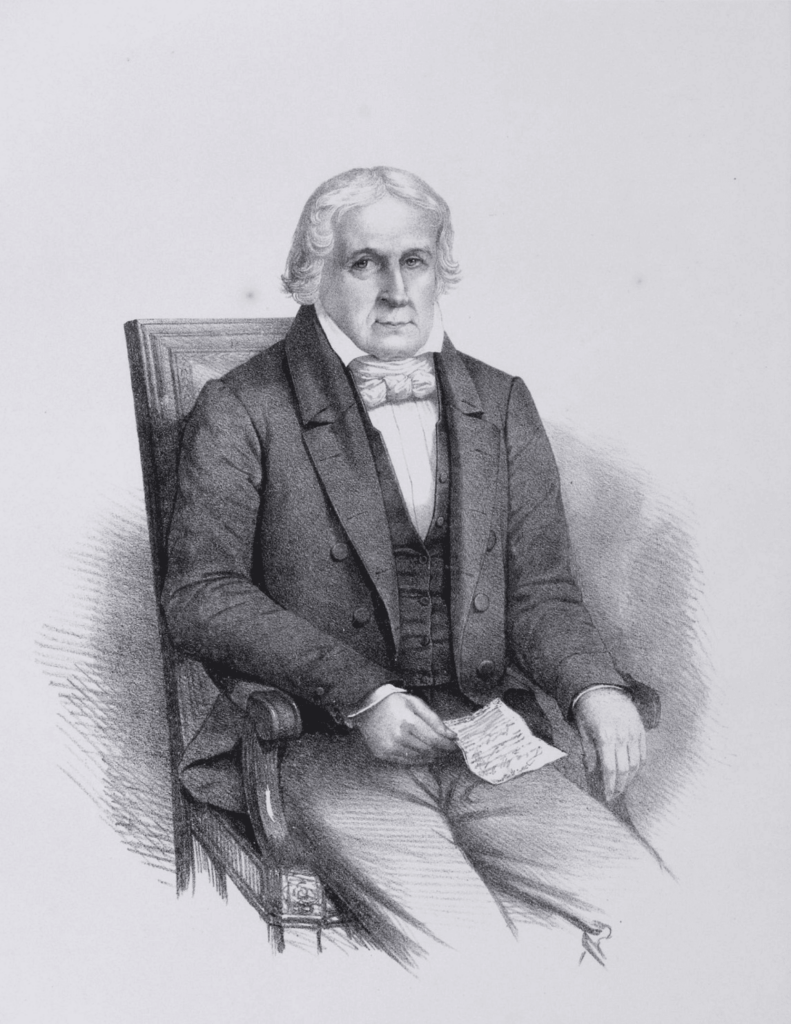
He was educated at the University of Coimbra, where he graduated in Law, Philosophy and Natural Sciences. In Brazil, he became the main minister in Pedro’s government.
José Bonifácio refused to take out international loans so as not to generate debts to be paid off by future generations; he proposed the creation of a Navy capable of protecting Brazil’s immense coastline and keeping the other provinces under the control of the metropolis.
He was a man of remarkable vision and the fate of our country would have been different if his ideas had prospered. But José Bonifácio’s bold projects ran counter to powerful interests.
He had managed to displease wealthy Portuguese merchants, slave traders and large landowners. And he also fought with the radicals, those who wanted to establish a democracy in Brazil.
We can see that José Bonifácio’s thinking oscillated between progressive ideas in the social field and conservative ideas in the political field.
At the same time as defending the abolition of slavery, he acted in defence of a representative monarchy (where an assembly would be formed made up of deputies elected indirectly by the dominant groups of the population).
José Bonifácio led the movement to create the Constituent and Legislative Assembly of Brazil. This proposal came about, however, after the famous “Dia do Fico”.
On 9 January 1822, Dom Pedro I’s decision to remain in Brazil was commemorated, in disagreement with the Portuguese Court’s demands for his return to Europe. This date became known as “Dia do Fico” (Stay Day).
At first, Dom Pedro’s act was not aimed at Brazil’s independence, as the prince followed the guidelines of the so-called “Coimbrã elite” (a group formed at the University of Coimbra, which wanted to bring about political reforms in Brazil and thus prevent its definitive separation from Portugal.
This group had a grandiose ideal: to build a Portuguese empire that would integrate Brazil and Portugal.
However, the plans of this illustrious elite did not succeed. The Portuguese troops left Rio de Janeiro after trying to embark the prince to Portugal.
There was resistance and, with the support of the population, Dom Pedro refused to take his place alongside Dom João. There was no alternative for the Portuguese army but to leave Brazil and take the news of the latest events with them.
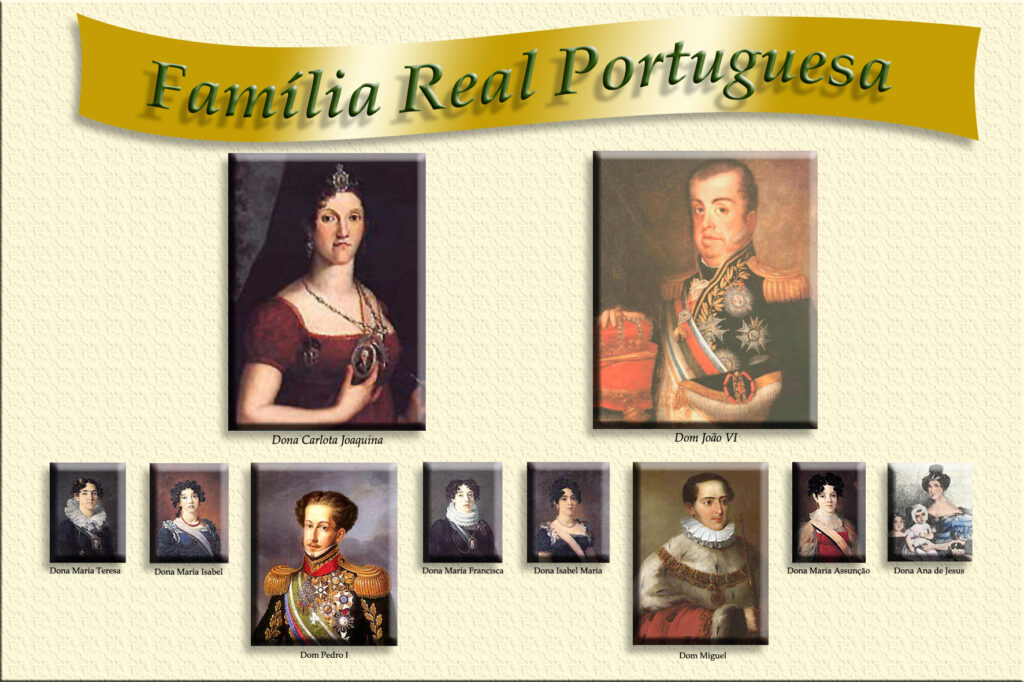
5. Grito do Ipiranga – Long live the King, Long live Brazil
Less than a year after “Dia do Fico”, Brazil’s independence was formalised.
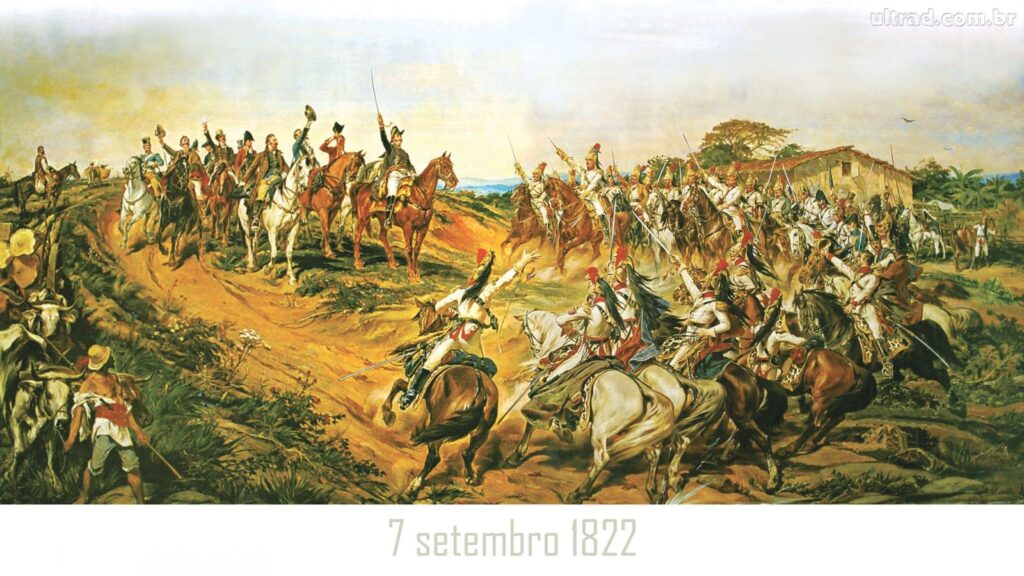
The episode entered the annals of history as the “Grito do Ipiranga“, when the then 24-year-old Prince Dom Pedro announced Brazil’s independence on the banks of the Ipiranga stream.
However, it wasn’t until December 1822 that he was appointed king, in a religious but fundamentally political ceremony.
Dom Pedro’s coronation ceremony had an important political and cultural function in the kingdom that was being born;
It cleverly recaptured this date, as the Portuguese celebrated the end of Spanish rule on that day.
It was a way for Brazil to explain to Portugal that it would no longer be a colony, that it would submit to its rule, just as Portugal had become independent from Spain.
The introduction of the coronation differentiated the Brazilian monarchy from the Portuguese, and was a completely new rite for the Bragantine dynasty.
This rite transcends the recognition of men, since the sovereign receives a task prescribed by God in the Church, just like a bishop.
This gesture reinforced the mystical union between the people and the sovereign, precisely because it had always been inscribed in the divine plans – as Friar Sampaio commented in the coronation sermon in the royal chapel.
We can’t help but hypothesise that a crowned monarch would have greater appeal among the black, African and freed classes, who revered the feast and the empire of the Divine Holy Spirit and the kings of Congo – thus facilitating his reception.
This passage from the book “The Independence of Brazil” by Iara Souza brings us face to face with an important symbolic ritual: the crowning of the king.
Today, in our society, we witness and/or participate in a series of rituals: christenings, debutante balls, weddings, burials, etc.
These rituals serve to mark a moment of passage, of transformation in our lives, but they can also legitimise the power of a leader.
In our country’s presidential system, for example, the elected candidate officially becomes president after receiving the presidential sash from the head of the nation who preceded him.
Therefore, celebrations can also be presented as a legitimisation ritual, in other words, as an event to promote a particular personality.
Although Pedro proclaimed independence in 1822, Brazil’s emancipation actually took place over a longer period of time.
We can say, for didactic purposes, that Brazil’s independence took place between the arrival of the Court and its proclamation (1808 – 1822).
So we have independence as a process, which involved various characters, both national and foreign. Incidentally, we should remember that a nation only becomes “independent” in its relationship with other countries, opposing or allying with them.
5.1. Pedro Américo’s painting “Independence or Death”, done in 1888
Pedro Américo’s painting “Independência ou Morte” (Independence or Death), done in 1888, better known as “O Grito do Ipiranga” (The Cry of Ipiranga) shows Pedro I in the centre raising his sword on the banks of the Ipiranga River and decreeing the Independence of Brazil (7 September 1822), on the right the knights of the entourage and on the left troopers curiously watching the scene.
The work was commissioned by Emperor Pedro II to exalt Pedro I and commemorate the birth of the nation and the Brazilian Empire and to relate the decline of the Brazilian monarchy to the Proclamation of the Republic, and to invest in the construction of the Ipiranga Museum in São Paulo, the Paulista Museum where the painting is today.
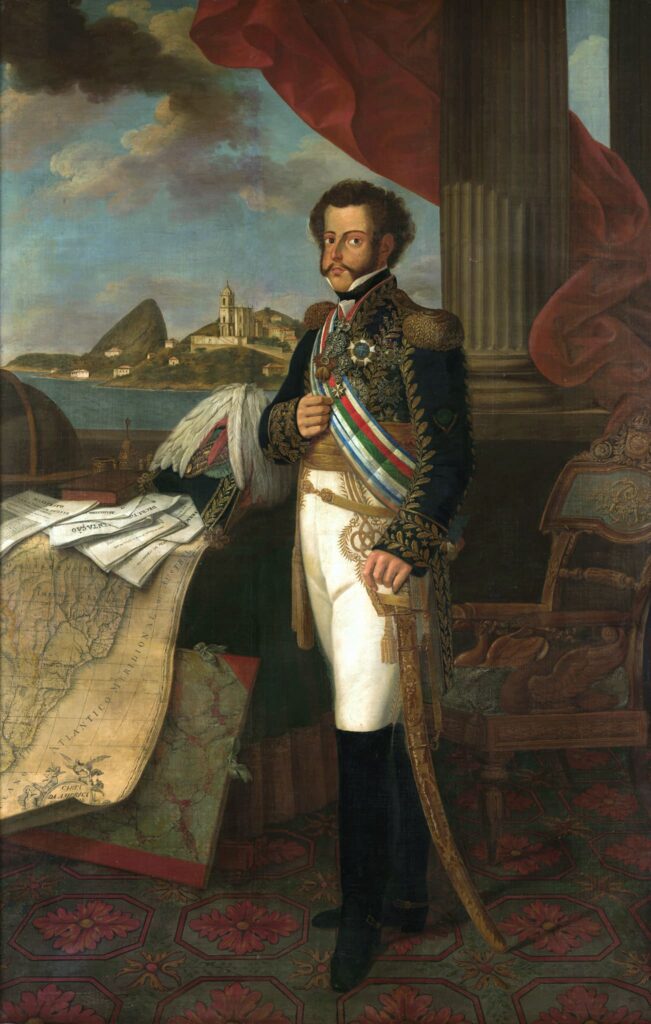
The image symbolises the proclamation of Brazil’s Independence, consecrated the 7th of September, but does not accurately relate the moment when Pedro I returned from São Paulo, received the letter from Portugal and declared Brazil’s Independence.
The scene was produced by Pedro Américo’s imagination, since it would be impossible to make a real connection between the painting and what happened due to the great difference in time (the painting was done in 1888 and Independence took place in 1822) and the lack of reports.
There are significant contradictions: it was not appropriate to make long journeys on horseback, but with mules; the clothes worn by the prince and his entourage were too gallant for the journey; the entourage was not so numerous and there are no records in documents of the prince having uttered the phrase “Independence or Death!”.
The painting depicts the episode in a grandiose way, not imitating reality, but recreating ideal beauty, praising the Empire and the nationalism of Brazil, which had recently proclaimed independence.
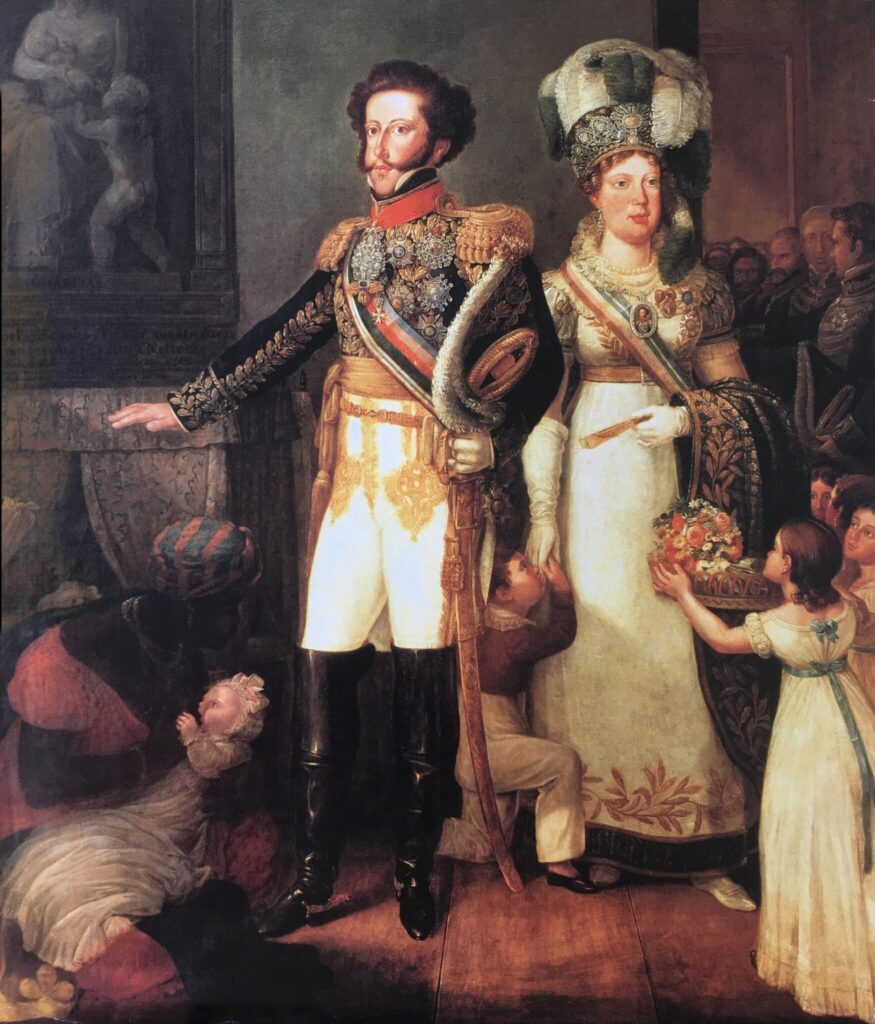
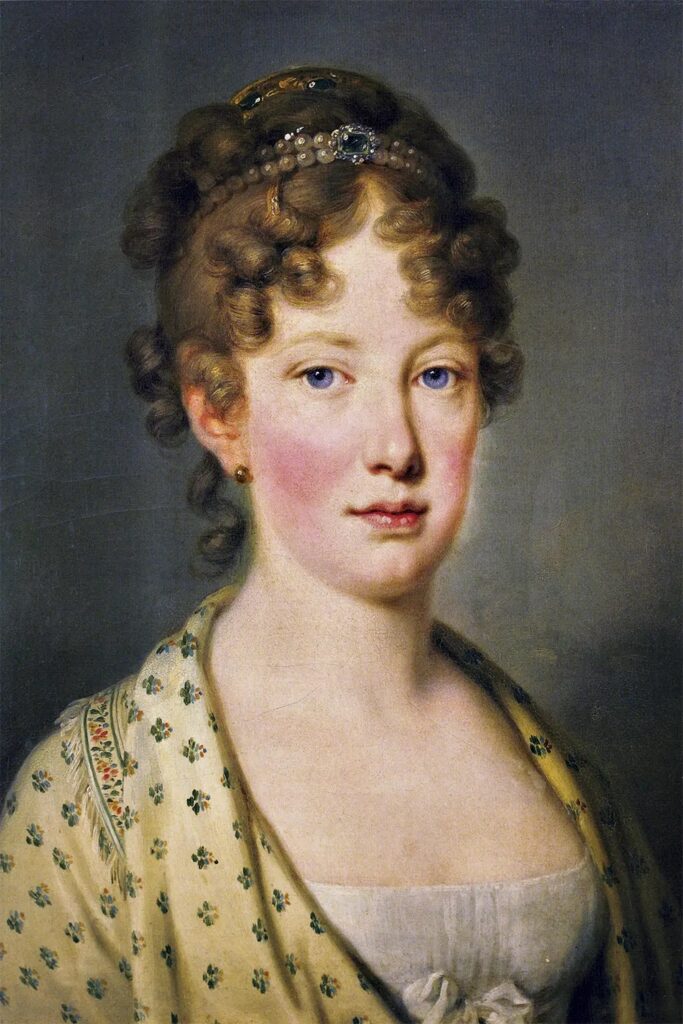
6. Action of secret societies
The study of the societies that existed in Brazil from the end of the 18th century onwards requires an analysis of their true role in our political movements.
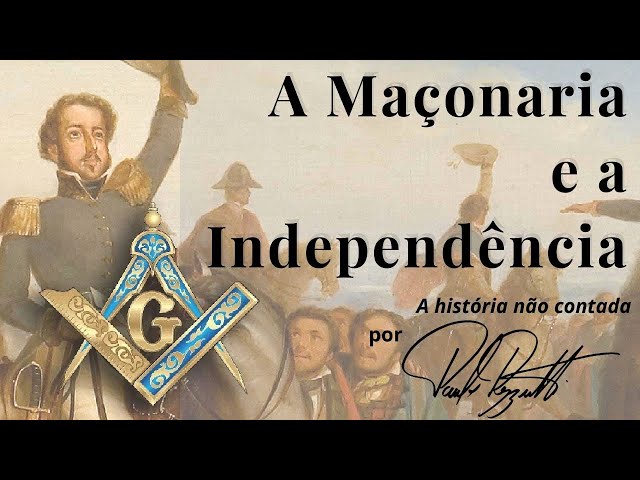
A Maçonaria e a Independência do Brasil
In fact, the very existence of most of these societies is only known through their political action.
Some developed more or less rapidly as a result of the principles they embodied, the organisation they assumed and the projection their members would achieve.
However, the model of a secret society that has acquired a decisive place in our history is provided by Freemasonry.
It is extremely difficult, if not impossible, to determine today how these societies functioned or whether they had other objectives than those specified in their programmes.
But the Apostolate is all purely political; because its end is to constitute the Empire of Brazil in a way that I will say [… According to A Sentinela de Liberdade, from Pernambuco, number 47, it is a club of corrupted or stupid aristocrats, propagators of the evil faith of absolutist monarchy, despotism and atrocious tyranny, aimed at preserving a branch of the Braganza dynasty, absolute and arbitrary, so that we can be flogged with the irons and bones of our ancestors, who suffer so much for being weak.
According to Frei Caneca himself, this society also operated in Rio de Janeiro.
While other societies, secret or not, functioned within the country itself, with only regional scopes, Freemasonry developed throughout the colony, coming from the kingdom, directly or not, and above all from French and English universities.
This international character gave it strength and prestige, especially in Brazil.
Its origins are practically ignored, as the Freemasons themselves who discuss the issue do not agree with each other.
Of all these discussions, the most likely thing we know is that it was originally linked to the old brotherhoods of masons, hence the name adopted.
These brotherhoods had initiation rites and building secrets that naturally remained within the circle of initiates.
Leaving aside the problem of origin, which doesn’t directly concern us, let’s turn to the undeniable fact of the great development that Freemasonry began to have in the 18th century and the important action it exercised at the end of that century and the beginning of the 19th all over the world.
Among the principles considered sacred to Freemasons, there is a whole individualistic liberal philosophy taken from the 18th century Enlightenment or resulting from a convergence in the same direction.
According to the Masonic Syllabus, freedom of thought and rationalism are the fundamental principles of society.
Freemasonry accepts members of any religion, and its concept of the “Great Architect of the Universe” has no connection with the belief in God in the various religions.
With liberal-democratic ideals – the motto of the liberal-democratic revolutions: liberty, equality, fraternity, is of Masonic inspiration – Freemasonry will maintain a political position characterised by the fight against absolute powers. It is in this position that we find an explanation for the great spread of Freemasonry.
The spread and consequent development of Lodges with political aims, in France and other absolutist countries, is a response to the status quo.
In fact, the Masonic ideological principles, corresponding to the individualist liberal ideology, would define the interests of the rising bourgeoisie.
That’s why Freemasonry was adopted and accepted by all those who didn’t want to pass themselves off as reactionaries in the late 18th and early 19th centuries.
Organised ideologically, Freemasonry then took a definite revolutionary stance against the absolutist powers.
An ally of the liberal movements, the secret society also sought to make its presence felt in the major political events that could bring about a transformation capable of affecting the absolute monarchies.
Thus, not only will it turn its members into revolutionaries, but it will also try to attract people capable of exercising political power.
Thus, in our country, Pedro I became a Freemason, not so much because he made Masonic ideals his own, but because it was in Freemasonry’s interest to make him a Freemason.
As for the date when Freemasonry entered Brazilian territory, nothing can be said with precision, as there is no consensus even among Masonic historians. We have found different reports of its presence since 1788, but there is no known document that confirms it.
It is certain, however, that Freemasonry must have been introduced along with the Enlightenment ideas acquired by Brazilian students in Europe, who often went on to complete their studies in France and England after finishing at the University of Coimbra.
The University of Montpellier, considered one of the Masonic centres of the time, was one of the most frequented by Brazilian students.
It was attended by José Joaquim da Maia, Álvares Maciel, Domingos Vidal Barbosa and others.
In 18th century Europe, Freemasonry developed and acquired prestige thanks to the rise of the bourgeoisie and the spread of Enlightenment ideas, whereas in Brazil the lack of a bourgeoisie as a class prevented a similar process.
What Freemasonry will reach in Brazil is therefore not the class that is most accessible to it on the Old Continent.
Here, the privileged are the sons of lords; the sons of those landed aristocrats who go to study at European universities.
Only these, therefore, will have the opportunity to get to know the philosophy of illustration; only these can get the books of Voltaire, Rousseau, Montesquieu and others into Brazil and, given the relationship between Freemasonry and illustration, only these can be initiated into Freemasonry.
Let’s also not forget the liberating objective that society acquired in the American colonies.
It was therefore interesting that these settlers, who went to Europe to become enlightened, also learnt about secret societies, not only because, in a way, this gave them prestige and brought them up to date with current socio-political changes, but also because it made them interested in the liberation of their land.
7. In this chapter you saw that:
- The period between the arrival of the Court and the proclamation of Brazil’s independence represents a transitional space between the Colony and the Brazilian Empire.
- Brazil’s independence was the result of a political, economic and cultural process.
- Pernambuco’s reaction to the economic inequalities between the northeast and southeast regions resulted in an important anti-Lusitanian movement.
- The Liberal Revolution of Porto resulted in the return of Dom João VI to Portugal (1821), and the proclamation of Brazil’s independence.
Discover the periods of colonial Brazilian history below:
- Portuguese Maritime Expansion and the Conquest of Brazil
- Occupation of the African Coast, the Atlantic Islands and the Voyage of Vasco da Gama
- Pedro Álvares Cabral’s expedition and the Conquest of Brazil
- Pre-colonial period in Brazil: “The Forgotten Years”
- Installation of the Portuguese Colony in Brazil
- Installation of the General Government in Brazil and the Founding of Salvador
- Monoculture, Slave Labour and Latifundia in Colonial Brazil
- Colonial sugar mills in Brazil
- The Iberian Union and the Dutch Invasion of Brazil
- Foundation of the city of São Paulo and the Bandeirantes
- Between the colonial regime and the establishment of the Empire in Brazil
- Transfer of the Portuguese court to Brazil
- The Portuguese Empire in Brazil
- Independence of Brazil – Breaking of colonial ties in Brazil
- Historical Periods of Brazil
